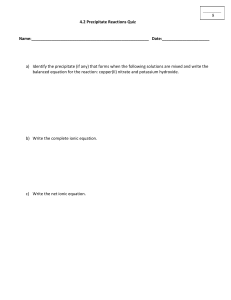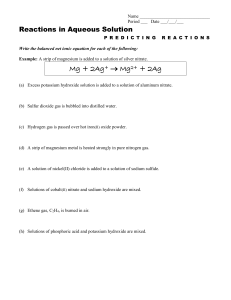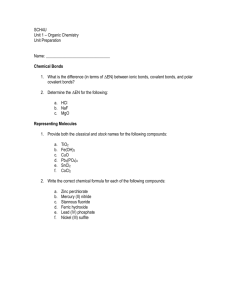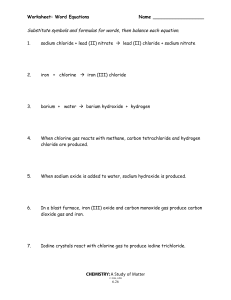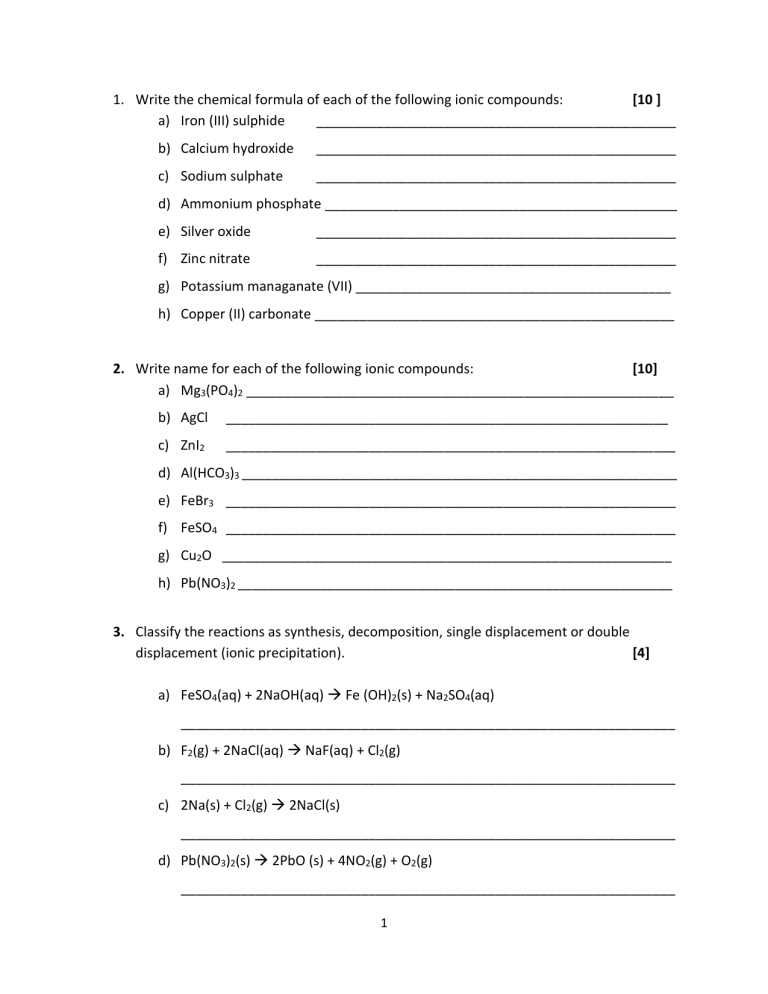
1. Write the chemical formula of each of the following ionic compounds: [10 ] a) Iron (III) sulphide ________________________________________________ b) Calcium hydroxide ________________________________________________ c) Sodium sulphate ________________________________________________ d) Ammonium phosphate _______________________________________________ e) Silver oxide ________________________________________________ f) Zinc nitrate ________________________________________________ g) Potassium managanate (VII) __________________________________________ h) Copper (II) carbonate ________________________________________________ 2. Write name for each of the following ionic compounds: [10] a) Mg3(PO4)2 _________________________________________________________ b) AgCl ___________________________________________________________ c) ZnI2 ____________________________________________________________ d) Al(HCO3)3 __________________________________________________________ e) FeBr3 ____________________________________________________________ f) FeSO4 ____________________________________________________________ g) Cu2O ____________________________________________________________ h) Pb(NO3)2 __________________________________________________________ 3. Classify the reactions as synthesis, decomposition, single displacement or double displacement (ionic precipitation). [4] a) FeSO4(aq) + 2NaOH(aq) Fe (OH)2(s) + Na2SO4(aq) __________________________________________________________________ b) F2(g) + 2NaCl(aq) NaF(aq) + Cl2(g) __________________________________________________________________ c) 2Na(s) + Cl2(g) 2NaCl(s) __________________________________________________________________ d) Pb(NO3)2(s) 2PbO (s) + 4NO2(g) + O2(g) __________________________________________________________________ 1 4. Balance the following equations by putting the proper coefficients where they are needed. [6] a) ___C4H10 + ___O2 ___CO2 + ___H2O b) ___FeS +___ O2 ___Fe2O3 + ___SO2 c) ___Mg(NO3)2 ___MgO+___ NO2+ ___O2 d) ___Fe + ___Cl2___ FeCl3 e) ___NaOH +___ H2SO4 ___Na2SO4 +___ H2O f) ___Fe + ___O2 ___Fe2O3 5. Write a balanced chemical equation for EACH of following reactions: a) The reaction between calcium and hydrochloric acid (HCl) aqueous to form calcium chloride and hydrogen. __________________________________________________________________ [2] b) Zinc hydrogen carbonate reacting with nitric acid (HNO3) to form zinc nitrate, carbon dioxide and water __________________________________________________________________ [2] c) The reaction between aluminium and chlorine gas to make aluminium chloride. __________________________________________________________________ [2] d) The reaction occurring when chlorine gas is bubbled into aqueous potassium iodide, which forms potassium chloride and iodine. __________________________________________________________________ [2] e) The formation of copper (II) oxide, nitrogen dioxide and oxygen when copper (II) nitrate is heated. __________________________________________________________________ [2] 2 6. Write the ionic equation for each of the following reactions: a) Pb(NO3)2(aq) + 2NaCl(aq) PbCl2(s) + 2NaNO3(aq) __________________________________________________________________ [2] b) KOH(aq) + HNO3(aq) KNO3(aq) + H2O(l) __________________________________________________________________ [2] c) Mg (s) + 2HCl(aq) MgCl2(aq) + H2(aq) __________________________________________________________________ [2] d) Aqueous aluminium nitrate reacting with aqueous sodium hydroxide to form insoluble aluminium hydroxide and soluble sodium nitrate.(include state symbols) __________________________________________________________________ [3] e) The reaction between lead (II) nitrate solution and sodium chloride solution to form insoluble lead (II) chloride and sodium nitrate solution. (include state symbols) __________________________________________________________________ [3] 3 7. State whether EACH of the following ionic compound is soluble or insoluble in water: Compound Silver nitrate Soluble /Insoluble Potassium phosphate Zinc hydroxide aluminium sulphate Lead(II) chloride Copper (II) oxide Calcium carbonate Sodium ethanoate [8] Total 60 marks 4

